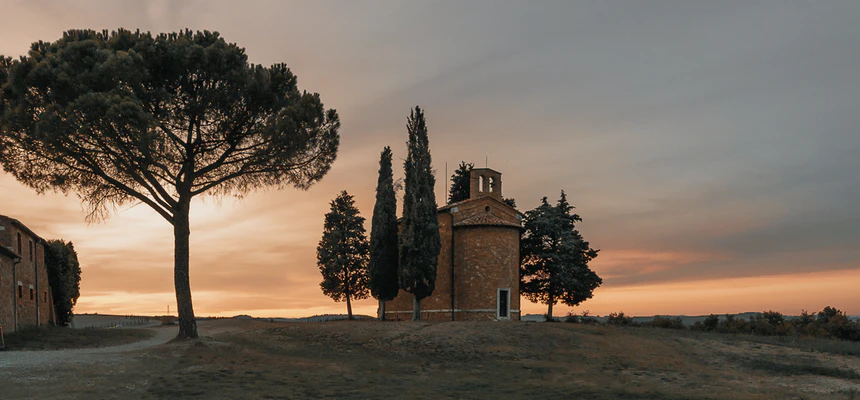
Pope Honorius II was born as Lamberto Scannabecchi on 9 February 1060. His family was from a small commune in north central Italy, 19 miles from Bologna. His environment was a humble farming community.
At a young age, Lamberto became the archdeacon of Bologna, an administrative role, a step below the bishop. Soon, Lamberto came to the attention of Pope Urban II (d 1099), who appointed him cardinal priest of an unknown church, possibly S Prassede. Pope Pascal II (d 1118) made him a Canon of the Lateran, a group of priests and laymen who live the preferred monastic-like lifestyle. Lamberto then became cardinal bishop of Ostia in 1117. He accompanied Pope Gelasius II into exile and was with the Pope when he died in 1119.
Lamberto and Cardinal Cono of Palestrina conducted the election of the new Pope according to canon law. Guy de Bourgogne was crowed Pope Callixtus II. As a papal legate, he worked closely with the Pope, assisting in negotiations with Henry V, trying to eliminate lay investiture. Eventually, Lamberto mandated an assembly at Mainz on 8 September 1022. He concluded with the Concordat of Worms and the Pactum Calixtinum, an agreement to not give the kings and emperors carte blanche to pick the bishops.
The pontificates of Urban II and Pascal II saw growth of Italian clerics among the cardinals, strengthening the Roman influence. Callixtus promoted mainly French or Burgundian cardinals. He died 13 December 1124. The Italians saw the northerners as innovators and wanted to resist them. The northerners wanted another northern cardinal. Roman families took sides. The Frangipanis supported the northerners, the Pierleoni supported Saxo de Anagni.
At the election on 16 December, the cardinals unanimously voted for Theobaldo Boccapecci, backed by the Pierleoni. At the beginning of the consecration service, an armed party of Frangipani supporters invaded the chapel, attacked and hurt the new pope, who had just taken the name Celestine II. They acclaimed Lamberto to be Pope. Celestine, not yet consecrated, offered to resign, but the Pierleoni were against it. Lamberto was consecrated during the melee, taking the name Honorius II.
Rome reacted. Cardinal Aymeric and the Frangipani tried to bribe the city prefect and the Pierleoni. Anyone supporting Celestine left him. Honorius was left. He felt the election was invalid. So, he resigned and was immediately re-elected and consecrated on 21 December.
PAPACY
Unfortunately, Honorius II was a creature of Cardinal Aymeric and the Frangipani family. Petty wars wasted his time and energy.
Between 1125-1128, his papal forces battled the Norman robber barons of southern Italy, eventually moving the arrested antipope Gregory VIII from Monte Cassino to Fumone.
In the same years, Honorius argued with the abbot of Monte Cassino, who he accused of being self-serving. Abbot Odensio, who saw the Pope as a mere peasant, was deposed. Honorius claimed that the new abbot was not canonically elected and he demanded the provost, Seniorectus, be abbot.
The on-again, off-again relationship between popes and the southern Italian Normans rose its head again. Roger II of Sicily wanted Apulia and Calabria. Honorius used Cardinal Aymeric and Cencio II Frangipani as negotiators. The interesting point is that Cencio was the man who beat and imprisoned Pope Pascal II. The negotiation finally gave Roger II the duchy of Apulia on 22 August 1128. However, there was still fighting at Benevento at Honorius’ death.
At Cluny, Abbot Pons took possession of the abbey after returning from the Levant. He melted down the treasures of the abbey, paid his followers and terrorized the monks and surrounding villages. Honorius ordered Pons to Rome, deposed him and imprisoned him at Frangipani’s castle.
King Louis of France attempted to control the reformers, Stephen, bishop of Paris, and Henri Sanglier, archbishop of Sens. Louis wanted his own version of lay investiture. Honorius tried to intervene with little success, at first.
In England, he had to deal with questions of jurisdiction between Scotland, York and Canterbury.
Honorius tried to send instructions to try to stabilize the kingdom of Jerusalem, but to little avail.
Early in 1130, Honorius got sick. Cardinal Aymeric and Frangipani moved him to a monastery while they planned what to do. Members of the Pierleoni broke in to force the election of their choice. He was still alive. When he did die, the cardinals buried his body quickly so as not to let many people hear the news yet. Mainstream cardinals elected Gregorio Papereschi as Pope Innocent II. The Pierleoni elected Pietro Pierleoni who took the name Anacletus II.
A new schism began.
External links: POPE HONORIUS II, THE INTERNATIONAL POPE (catholic365.com)
Internal links: POPE PASCAL II AND CONTINUED TROUBLES – Lanternarius Press

Recent Comments